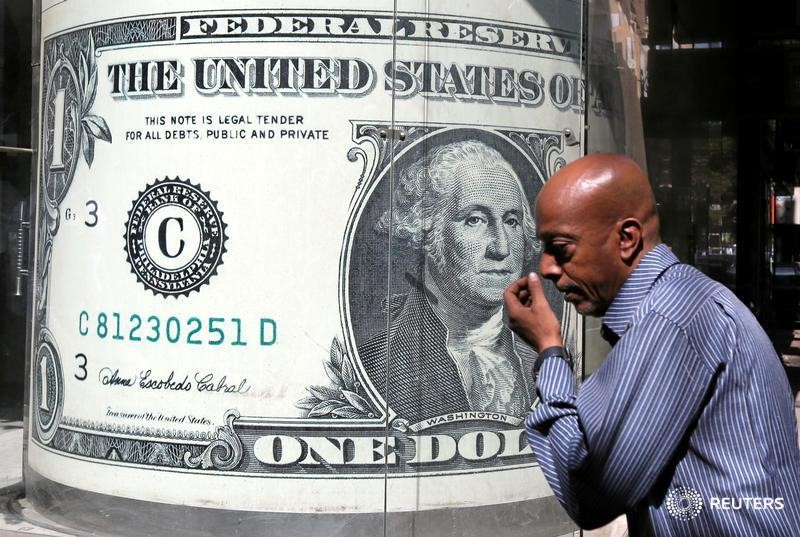Is this U.S.-China selloff a buy? A top Wall Street voice weighs in
(Recasts, adds detail on Trump plans for Chinese apps)
* Graphic: World FX rates in 2020 https://tmsnrt.rs/2RBWI5E
* Dollar rises after Trump targets Chinese tech companies
* Traders looking for more U.S. economic stimulus
* U.S. non-farm payrolls data at 1230 GMT in focus
By Stanley White
TOKYO, Aug 7 (Reuters) - The U.S. dollar bounced and the
yuan slumped on Friday after President Donald Trump took steps
to ban transactions with the Chinese owners of two popular
mobile apps.
The Australian dollar also fell, hurt by concerns about
worsening U.S.-China relations and the Reserve Bank of
Australia's downbeat assessment of the local economy.
The greenback's gains against the Swiss franc, the pound,
and the euro came as investors await the release of U.S.
non-farm payrolls later on Friday, which is forecast to show a
slowdown in job creation.
"Trump's comments hit Hong Kong stocks hard and helped the
dollar rebound against the euro and the Aussie," said Yukio
Ishizuki, foreign exchange strategist at Daiwa Securities in
Tokyo.
"The dollar has been sold quite a lot, so it could bounce a
little more, but there's uncertainty about how payrolls will
turn out."
Against the euro EUR=D3 , the dollar rose 0.44% to $1.1824
on Friday, pulling back from its weakest in more than two years.
The British pound GBP=D3 fell 0.37% to $1.3104, retreating
from its strongest level since March.
The dollar bounced from a five-year low against the
safe-harbour Swiss franc CHF= to trade at 0.9132.
Against the yen JPY= , which is also considered a safe
currency, the dollar traded at 105.57, not far from a four-month
low.
Trump on Thursday issued an executive order banning
transactions with ByteDance, the Chinese company that owns the
video-sharing app TikTok, saying the app is a threat to national
security. Trump also said he will ban transactions with Chinese firm
Tencent Holdings Ltd 0700.HK , which owns the WeChat messaging
app.
The bans, which will start in 45 days, mark an escalation of
a row over China's ambitions in the technology sector.
The onshore yuan CNY=CFXS fell 0.2% to 6.9670 per dollar.
Offshore, the yuan CNH=D3 headed for its biggest daily decline
in two weeks.
The Australian dollar AUD=D3 fell 0.48% to $0.7204,
pulling back from the highest in one-and-a-half years, after the
country's central bank cut its economic growth forecasts due to
a resurgence of the coronavirus in Melbourne. Across the Tasman Sea, the New Zealand dollar NZD=D3 fell
0.25% to $0.6667.
The U.S. dollar has been caught in a persistent sell-off due
to a combination of rising U.S. coronavirus infections, a steady
decline in Treasury yields, and a lack of consensus in
Washington over additional fiscal stimulus.
Analysts say the dollar will continue to fall, particularly
against the euro, the yen and Swiss franc, as expectations for a
V-shaped recovery from the coronavirus epidemic fade and
investors take a more sanguine view of markets.
Non-farm payrolls due later on Friday are widely expected to
show U.S. jobs creation slowed in July from the previous month,
indicating a resurgence in coronavirus infections is undermining
the economic recovery there.
Earlier this week, the five-year Treasury yield US5YT=RR
hit an all-time low, and the benchmark 10-year yield US10YT=RR
fell to its second-lowest ever, further reasons to shun the
greenback.
The dollar index against a basket of major currencies USD=
last stood at 93.088, rising from a two-year low.
U.S. Republicans and Democrats have so far failed to reach
an agreement on the cost of fiscal stimulus measures that many
investors say is necessary to prevent the economy form losing
more momentum. Spot gold XAU= , another asset sought during times of
heightened uncertainty, rose to a record high early in Asian
trading but then fell as the dollar staged a mild recovery.
